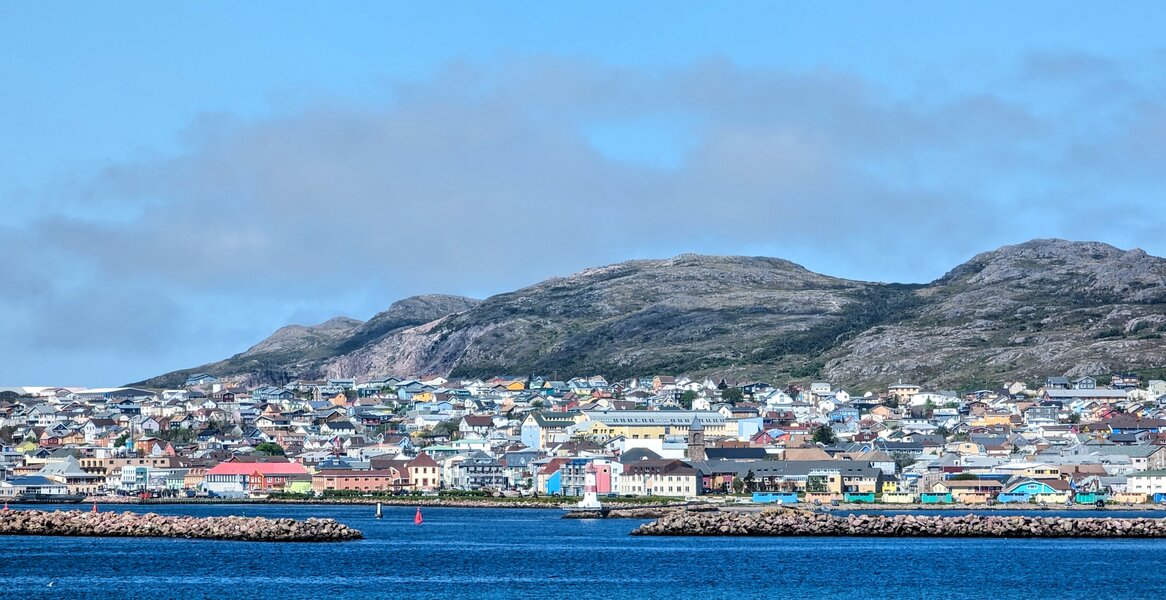Travel
Americans Can Now Drive to France

As our ferry sliced through the early summer mist, St. Pierre played a game of hide-and-seek. One moment the island’s brightly painted buildings splashed a pop of color against the grey Atlantic—then the whole thing vanished like a mirage into the chilly Grand Banks fog.
For my husband Evan and me, the inspiration to visit this little piece of France—eight islands just 12 miles off Newfoundland’s southern coast—struck a few weeks earlier while listening to “French Perfume” by Newfoundland’s Great Big Sea. We were setting the mood for our upcoming Newfoundland and Labrador road trip when the lyrics, which hint at St. Pierre and Miquelon’s smuggler past, sent me straight to Google.
I was captivated by photos of the windswept and mysterious archipelago. And what I read piqued my curiosity even further: St. Pierre and Miquelon (SPM to locals) boasts just 6,000 residents and blends Basque, British, Canadian, and—of course—French influences. But what really struck me was a relatively recent $55 million CAD investment by the French and Newfoundland Labrador governments. They were keen to boost tourism between the destinations through two ferries—which finally became fully functional in 2021, after a six-year saga—and I was happy to turn our itinerary international.
After checking the ferry schedule, I booked a room at family-owned Auberge Quatre Temps (lodging can fill up, so book before the ferry!) The 188-passenger, 15-car ferry departs up to eight times a week from a small town on Newfoundland’s Burin Peninsula called Fortune. After checking in, we simply walked aboard—driving to this part of France is so new that, like many other passengers, we didn’t realize bringing a car was an option until it was too late.
After settling into the comfortable passenger cabin, several co-passengers on our 90-minute trip told me they were also traveling to St. Pierre on a whim.
“We were in a restaurant, looking at a map of Newfoundland, and I noticed an international border just off the coast,” one woman explained. Curious, she’d asked around. “I wanted to go to France for the Olympics. So here we are,” she added, gesturing to her family.
Despite my quick Googling, my knowledge of this last remnant of France’s once-vast North American empire was pretty limited when set out on our European-ish detour. Here’s what I did know: Thanks to quirks of geography and law (as a French territory, SPM wasn’t subject to US regulations) the archipelago was a key supplier of booze during Prohibition. Over a few short years, it transformed from a remote fishing outpost into a hub of criminal trade that has birthed bootleggers, rumrunners, and millionaires.
Despite being located closer to puffins and icebergs than American speakeasies, 1920s St. Pierre and Miquelon once bustled with businessmen, smugglers, and gangsters, according to tour guide Eléa De Arburn. As she led us through hilly streets lined with compact Peugeots and Citroëns (and a big Ford truck which stood out both for its size and novel South Carolina plates), the university student, who was back home for summer break, spun a tale of how the quiet Basque fishing port, once tussled over by the French and English, grew to have an unlikely influence on US culture.
Prohibition also altered the small town’s architecture in the form of storage warehouses, banks, and office buildings. The French government of the time also spent millions upgrading the port—and shipped entire buildings across the Atlantic for reassembly here. Even with the new infrastructure, space for all that alcohol was still inadequate. Eléa explained that companies were forced to rent people’s basements and used them to store millions of bottles of liquor and pointed out one house’s particularly sturdy-looking cellar door.
Unlike some of the rougher homemade spirits that flowed in Prohibition-era America, the liquor that came through SPM was top shelf. “Those gangsters were serious about quality,” Eléa told us. This commitment to product even gave us a new saying; any alcohol smuggled by the infamous Bill McCoy, who ran rum, gin, and French wines from SPM’s harbor to the “rum line,” or the US’s three-mile limit, was guaranteed quality stuff. Hence the phrase: “the real McCoy.”
After a morning steeped in history, we were ready to dive into the local cuisine. St Pierre’s compact town center clusters around its protected harbor and is easily walkable. After passing a couple of shops that had already closed for lunch, we ducked into the unpretentious Le Feu De Braise for the kind of bountiful meal of fresh lobster and mussels that wouldn’t have been out of place in coastal Brittany.
Afterward, we walked back down to the waterfront and to a row of brightly painted fishing sheds. That’s where we met Gérard Hélène, president of Les Zigotos, a local association that’s passionate about saving the St. Pierre working dory: the archipelago’s once-ubiquitous flat-bottomed wooden fishing boat.
Gérard, a descendant of SPM’s first dory builders, is deeply committed to preserving this older part of SPM’s history. Soon, he and my boat-loving husband were leaning over one of the crayon-colored hulls, throwing around words like “sheer” and “rocker.” Happy to leave them to it, I wandered into the club’s little museum and took in the photos and artifacts celebrating the heyday of the cod fishery. The smell of salt and old wood filled the room, evoking a time when these dories were essential to life on the islands.
To dig deeper into SPM’s roots, the next morning we boarded a modified fishing boat called Le P’tit Gravier for the 10:30 a.m. water taxi ride across the harbor to uninhabited Île Aux Marins (Sailors’ Island). At first, I thought we’d gotten the time wrong. SPM operates on its own time zone, a half-hour ahead of Newfoundland, but depending on where I stood, my phone randomly jumped between Canadian and French carriers, leaving me perpetually unsure if I was late or early.
The arrival of Eléa (who seemed to be the guide for everything), along with several familiar faces from the ferry, assured me we’re on time. Soon we were strolling across the grassy island, learning about life when the church (Eglise Notre-Dame-des-Marins), fishermen’s homes, and schoolhouse buzzed with activity, and endless-seeming cod was laid out by the children to dry on the island’s expansive gravel beds. We also got a glimpse of the island’s French influence when we encountered locals carrying picnic supplies of brie, foie gras, and fresh baguettes. Eléa explained that not only is Île Aux Marins an open-air museum, it’s also a popular spot for getting away from it all on a sunny day. The tiny island even hosts a summer camp and soccer clinics for kids.
While most residents on SPM speak some English, our high school French was handy for reading menus and for helping a fellow ferry passenger find a liquor store. The woman, the same whose family booked their trip soon after she noticed the international border, hadn’t realized that bringing a car to the islands was still uncommon and automatically included their vehicle when she called the SPM Ferry office for reservations (cars can’t be booked online through the website–just over the phone.)
She told us having the car was making their stay more of an adventure; they’d been driving to far points of the island searching for French wine, but had only thus far located fresh pastries, a bookstore, lots of horses descended from those used for early transportation, and several incredible viewpoints. To save her another drive, I directed her toward nearby Boucherie-Épicerie Chez Julien, which also had an excellent selection of local pâté. In turn, she told us about some of the highlights from her car-based excursions, including a hike she’d done on St. Pierre’s northern end.
Catching a lift with a local, it didn’t take long to drive out of town and reach the trailhead for L’Anse a Henry. Treeless, rugged, and pockmarked with tiny ponds, I felt transported back to Newfoundland—which I could see on the horizon. Soon, we were in the middle of the island, where there was nothing but wind and the scent of briny sea mixed with northern plants like fragrant sweetgale and zesty Labrador tea. When we reached the island’s far side, the air filled with the sounds of seabirds as thousands of petrels and puffins took flight from nearby Grand Colombier. Out in the distance I caught sight of a small boat. It was easy to imagine an ancient Basque fisherman rowing his dory back from the fishing grounds, or a smuggler coming for another load of rum, or even a tour guide maneuvering their boat to show visitors the wildlife. Slowly a fogbank rolled in, concealing the boat entirely and ending my reverie.
The next day we took the ferry back to Newfoundland. Standing on the stern deck, I traded notes with some of the passengers we’d crossed paths again and again in the little French territory, reaching the consensus we’d need to return. One pointed out we could still see St Pierre’s striped lighthouse and then gasped as the fog thickened and swallowed both the lighthouse and the wondrous little island whole, “It’s like it was never there at all!”









